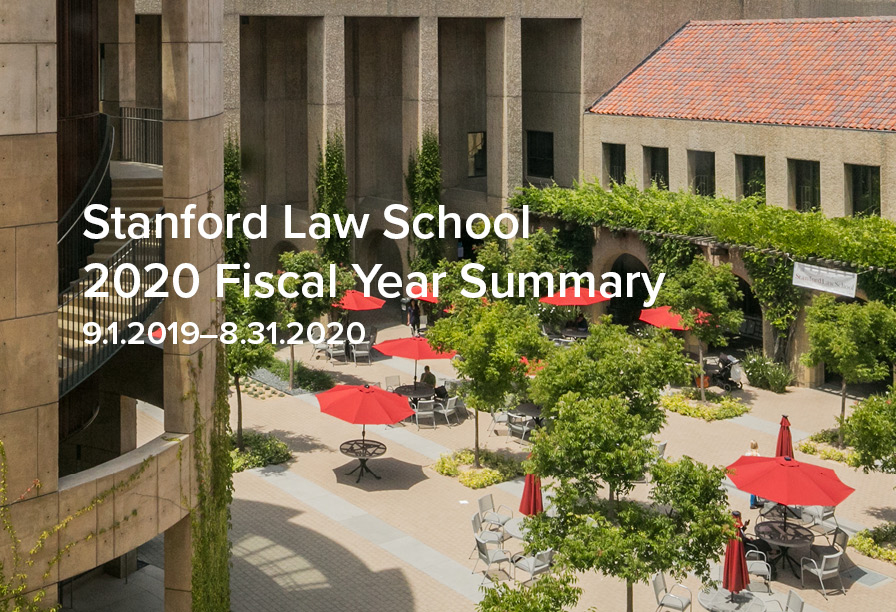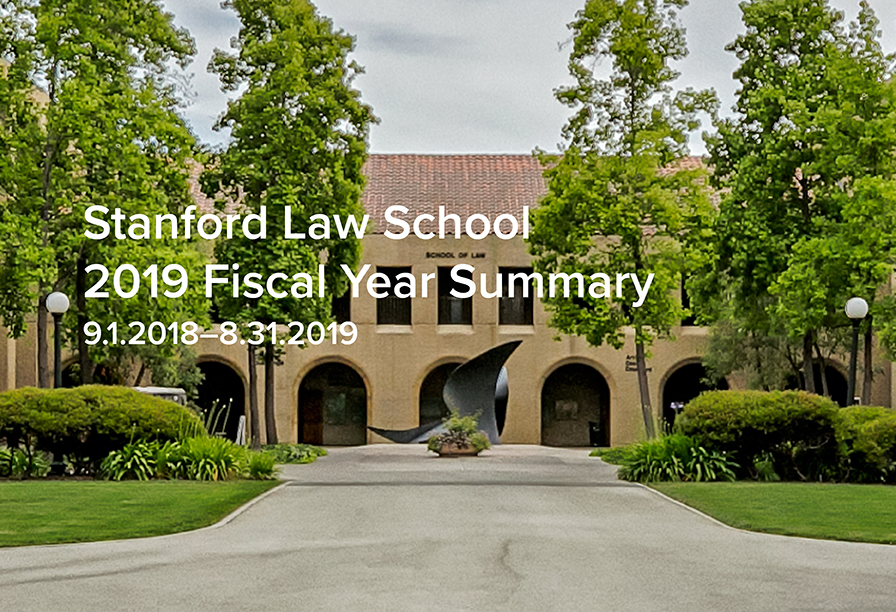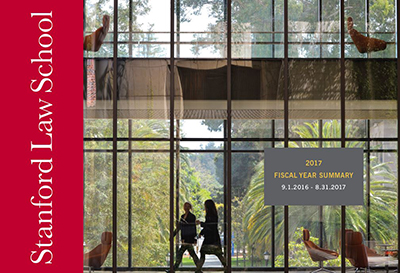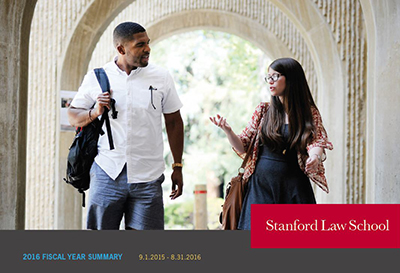
Stanford Law School
2021 Fiscal Year Summary
9.1.2020–8.31.2021
A Message from the Dean

In a year that included many obstacles, the Stanford Law School community showed its true colors. At their core, SLS alumni, faculty, students, parents, staff, and friends are among the most deeply empathetic and caring people around. It is because of people like you that SLS was able to meet the needs of our students, provide seed funding for faculty research, and do work at all levels to support our community. We are deeply grateful for all you have done and all you continue to do to support SLS and the people who call this place home.
—Jenny S. Martinez, Richard E. Lang Professor of Law and Dean
Financial Overview
Philanthropic support allows Stanford Law School to remain at the forefront of legal education. Your generosity helps SLS support faculty research on topics of global importance, provide essential financial aid for students and public-service and public-interest alumni, and develop timely solutions to some of society’s most pressing challenges. Thank you.
Sources of Income
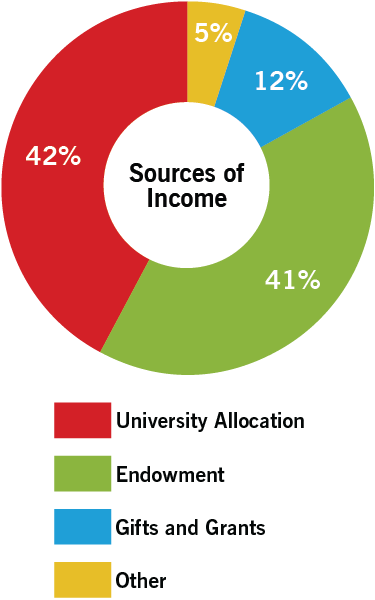
42%
University Allocation
The law school receives tuition, fees, and other general funds from the university.
41%
Endowment
Assets invested in the Stanford University endowment are an enduring source of financial support for the law school and are paid out at a rate of approximately 5.5% annually.
13%
Gifts & Grants
Yearly funding gives SLS the ability to enhance the student experience through developing innovative curricula, recruiting and retaining the best and brightest faculty, and engaging our world-wide alumni community.
6%
Other
Revenue from executive education and conference fees supports the law school’s programs and priorities.
Total Dollars Raised
$27,110,044*
*This figure includes both outright gifts and multi-year pledges committed during fiscal year 2021.
Uses of Income
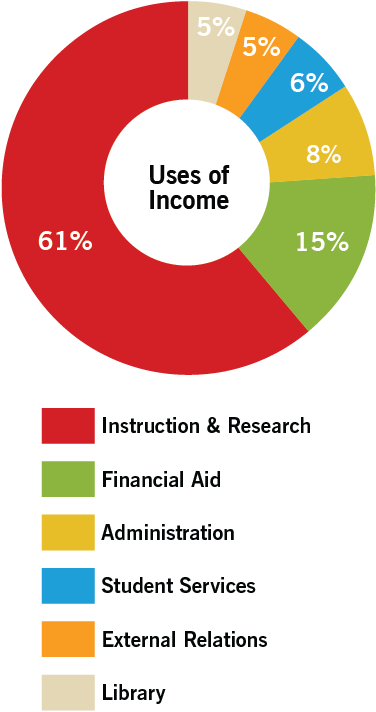
61%
Instruction & Research
Drives innovative research and supports distinguished faculty in the classroom, global program, clinics, and policy lab
15%
Financial Aid
Gives the majority of Stanford Law School students financial assistance and scholarships
8%
Administration
Sustains fundamental operations at SLS, including facilities maintenance, information technology, finance, and human resources
6%
Student Services
Supports the student experience beyond the classroom through programs and services such as the Levin Center for Public Service and Public Interest Law and the Office of Career Services
5%
External Relations
Connects SLS’s global alumni community to current students through communications, events, reunions, volunteer opportunities, and international programs
5%
Library
Maintains essential library services and research resources, including databases, subscriptions, and technology updates
Total Law School Budget
$89,336,080
Exceptional Students
Stanford Law School recruits exceptional students to study the law, and we invite them to attend irrespective of their financial means. Our need-blind admissions policy is foundational to this commitment. It means that students’ financial needs will be met each year that they are enrolled.
Equally important, our commitment to accessibility does not end with graduation. SLS also provides support for our graduates who are pursuing careers in the public interest and public service sectors. Funding from programs like our Loan Repayment Assistance Program and our Post Graduate Fellowships help our graduates enter these highly competitive fields without many of the financial constraints associated with working to serve communities in need.
Graduates of Stanford Law go on to lead, innovate, and inspire in many different ways, including public service. I’m blessed to have dedicated much of my legal career to government service, and know firsthand how important it is for prosecutors to be creative, open-minded, principled, and committed to integrity and the rule of law. Stanford has a distinguished tradition of fostering these attributes and I’m proud to support the Law School’s mission.
—Robert K. Hur, JD ’01

Meeting the Moment
As we educate the next generation of lawyers who will go on to become leaders in business, advocates, counselors, government officials, and so much more, we value the opportunity not only to train them in the fundamentals of the law, but also to facilitate opportunities for them to apply what they learn. Clinics have long been one way for students to engage in the application of skills to real-world situations. More recently, Policy Labs have given students similar opportunities to apply what they have learned in the classroom to questions of policy and governance. Below you can read one example of the important policy projects that our students and faculty are pursuing in order to help solve some of society's most pressing challenges.
Meeting the Moment: Redistricting
Redistricting in the United States is a legally required process of drawing new congressional and state legislative district boundaries to account for population shifts. Most redistricting takes place every 10 years, shortly after the release of the decennial U.S. census, and is conducted by state legislatures.
Draw Congress, a project developed under Stanford Law School’s Law and Policy Lab, is one of many efforts currently underway to influence or reform redistricting. Sixteen law students and six Stanford undergraduate students are participating in a crash course on the difficult process of drawing congressional maps that align with the 2020 U.S. Census. The initiative is led by renowned voting expert, Professor Nate Persily, the James B. McClatchy Professor of Law at Stanford.
“The goal of this project is to educate our students and the general public about this difficult and sometimes fraught undertaking, showing how districts can be drawn in a non-partisan, legally defensible manner,” said Persily. “We hope our maps, eventually made for all 435 U.S. House districts, will show how communities can be fairly represented and, unlike most incumbent-drawn maps, be transparent about redistricting decisions.”
Looking to the Future
The law is perpetually changing, with technology being a fundamental driver today. As we consider the future of the legal profession, we want to ensure that our students are best positioned to understand the challenges inherent in future practice, and have the skills that will make them exceptionally well-suited to ask the right questions at the right time. We will prepare our students to lead across sectors—in government, business, technology, and the public sector—helping society continue to understand and embrace the future.
As we seek to train lawyers to lead in transforming law, so, too, will we ensure Stanford Law School is positioned to lead across legal education. From experiential learning opportunities in Clinics and Policy, to a curriculum rooted in traditional doctrinal courses and leveraging opportunities of a 21st-century classroom and learning environment, we are committed to developing and implementing tools, training, and curricula that will serve not just our students and law school community, but that could be used by law schools across the country. We believe that these efforts will reap rewards not just for Stanford Law School, but for society as a whole.
Center on the Legal Profession
For more than a decade, the Center on the Legal Profession has been at the forefront of research, policy and advocacy, teaching, and public programs. It focuses on issues critical to the future of the profession including access to justice, diversity and inclusion, regulation of the bar, modernization of legal services, and lawyer leadership and well-being. These national efforts continue to be heavily influenced by the lifelong work of Professor Deborah Rhode.
This past year, the center welcomed new co-directors, Nora Freeman Engstrom and David Freeman Engstrom. While keeping Professor Rhode’s vision at the forefront of their work, the CLP has honed its focus to two themes:
- Legal Education for the 21st Century. CLP seeks to ensure that law students across the nation experience a legal education that values and prioritizes the skills required to be successful at the intersection of law and technology. Through convenings and publication, the Center has a leading role facilitating the alignment of law school curricula with competencies students need to be effective in the 21st century.
- Bridging technology and legal services. CLP leadership is leading the conversation about opportunities to expand the legal services model, using paraprofessionals, akin to nurse practitioners, to provide limited legal services to those who would otherwise not have access to the justice system.

